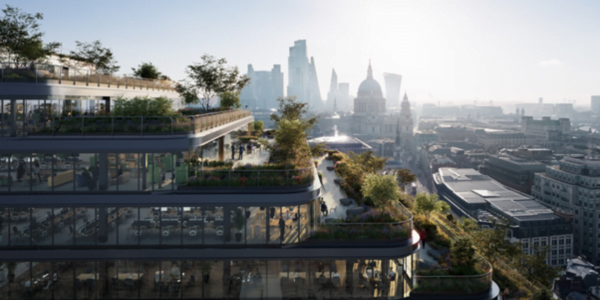Over the past few years, proposed projects in the City of London have gotten much greener. Why? It’s a combination of social consciousness, regulatory requirements, and looming CO2 targets for both the city and the entire U.K.
In this article we’ll take a look at one property that just gained planning consent in October 2021, and show some of the parallels to best practices seen throughout the world, and to Electracom’s philosophy specifically.
Case Study: 120 Fleet Street
The environmental impact of new construction is difficult to offset. The high embodied energy value of concrete and steel, as well as the energy and fuel used to undertake the construction process itself, is a sunk environmental cost. The benefits must be high and long lasting in order to justify this kind of environmental and monetary expenditure.
So a project as huge as the complete demolishing and repurposing of the former Daily Express newspaper HQ at 120 Fleet Street in London is going to attract a lot of scrutiny. This is valuable, high profile real estate. And it’s directly opposite another major development project due to break ground next year: The £300m Salisbury Square Development, a major court and police complex.
To say that the planning and design side of 120 Fleet Street needs to be ‘high quality’ is an understatement. It needs to be near-perfect. In function and appearance, the new site will have to be environmentally friendly, attractive, and useful all at the same time.
The plans that recently won consent feature a 21 story, 660,000 sq ft high-rise office complex that will dwarf everything in the immediate area. But the face of the building will remain at its iconic height, with the rest of the floors swept back away from the street. And the environmental concessions are unlike anything seen in that area before.
The use of Air Source Heat Pumps to produce the building’s low temperature hot water and chilled water (in conjunction with chillers) reduces fossil fuel reliance; coupled with water to water source heat pumps, utilising rejected heat to generate the building’s hot water requirements means that the services design is using best of class processes to meet Client aspirations.
Distributed air plant utilising demand ventilation control will reduce energy use whilst maintaining air quality regimes demanded by the post-pandemic expectations of incoming tenants.
The use of rainwater and grey water for WC systems and irrigation adds another level of sustainability, reducing the use of potable water supplies for functions in the building that do not demand it.
Extensive metering of the buildings energy will allow educated decisions in building operation and identify anomalies at the earliest stage through dedicated system analytics.
The top of the building will include a free, publicly accessible landscaped roof garden. Every floor above the 5th will include landscaped green terraces, sporting over 100 trees and bushes right up to the 20th floor. The entire south facing perimeter is designed to be green and exposed, taking advantage of the available light.
Sustainability is the watchword for this complex. Plans even include the building of a ‘Cycle House’ that has 85 short stay and 149 long stay parking spots for bikes. This should help take quite a few cars off the road and relieve parking strain in the area.
Demolishing the old building and grounds will take most of the next year, with basement works for the new facility starting in late Q4 of 2022. Then it’s a two and a half year build, with the project due for completion in or around April 2025.
Deputy Alastair Moss, the Chair of the City of London Corporation’s Planning and Transportation Committee, had this to say about the Fleet Street project:
“This development is yet another example of how the City can balance the constant demand for new office space, whilst maintaining due respect to the Square Mile’s unique history. Fleet Street is renowned as the former home of London’s newspaper industry and this development takes care to rejuvenate the old Daily Express building to the next chapter of its rich history. Importantly, it will also allow for a new, high-quality office to be constructed in this key strategic part of the City.”
Parallels with Electracom’s Philosophy
This is the kind of new construction that we can really get behind. Not only is the main building built with sustainability in mind, but it has the potential to embody modern green management plans.
By opening up the south facing, natural light and heat will be made accessible to offices and meeting spaces across a large swathe of the floorplan. With proper design there will be plenty of opportunities for the implementation of smart blinds, automatic light and heat options that adjust for the occupancy at any given time, and proper air flow management that will promote a healthy office environment.
Even better, the massive Cycle House should open up intelligent hot desking opportunities that can be centrally managed. This can be integrated with biometric security, to allow for seamless entry and exiting for employees that are on the go. In colder months, pre-heated air curtains can be used to minimise energy loss in high foot traffic areas around the building’s entry points.
The power management side will be critical in such a huge facility, particularly when the roof has public access. In order to maintain safe and comfortable passage between the ground floor and the roof, while still respecting the privacy and work needs of the building’s regular occupants, a fully automated access and environmental control system will need to be in place. It will all have to be tied in with on site security and the remote management console of the designated fire services team. But when these things are taken into account from the project’s inception, it makes things a lot easier when it comes to the vendor selection phase.
Long term planning is the key to success with any venture of this magnitude. Now that the laudable goals of the new 120 Fleet Street complex have been established, it’s time to execute. This will require quite a bit of forethought and technical expertise. 2025’s business environment will bear little resemblance to what we’ve seen in the past, even as recently as 2019. The landscape has changed, with remote work considerations and strict environmental controls being of paramount importance.
Every new office project requires a new level of flexibility, and the hardcore automation to back up such a design philosophy.
In Conclusion
London’s push to become greener is sending shockwaves through the industry and the populace itself. Just this week, the Ultra Low Emission Zone expanded to 18 times it’s initial size. It’s a sign of the times.
At Electracom, we’re doing our part. Our automation is at the leading edge of green office tech. We applaud the efforts of the City of London to modernise not only our aging infrastructure, but the way we think about coexisting with the world around us, even in the heart of one of the busiest cities on the planet.













